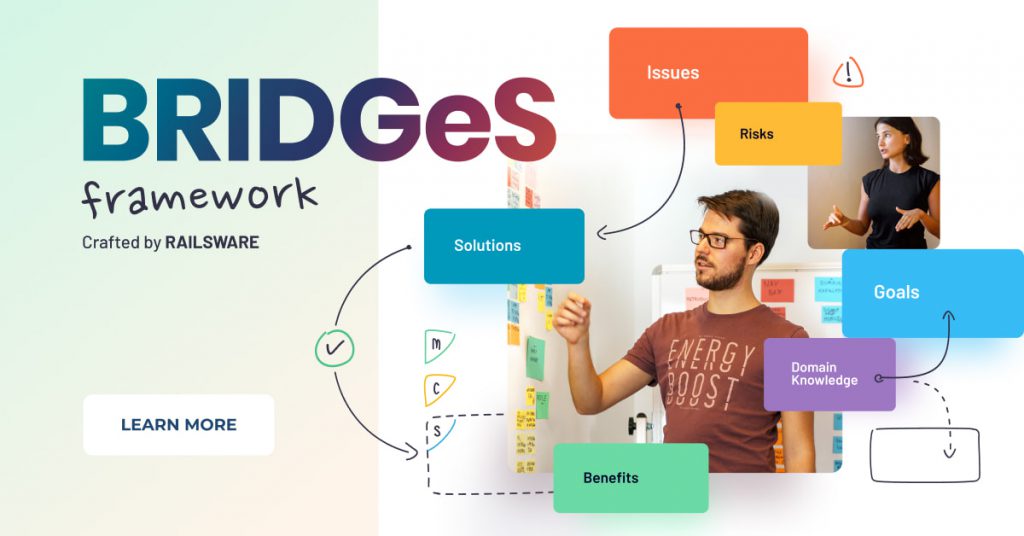There’s a multitude of factors that need to work out for a business to succeed. A great idea, the right team, knowledgeable advisors, and money to provide enough runway. And, of course, the determination to work day and night to deliver the product to the market.
But all this may not matter if no one buys the product the team was so diligently working on. And this is likely to happen if they neglect or skip one very important process.
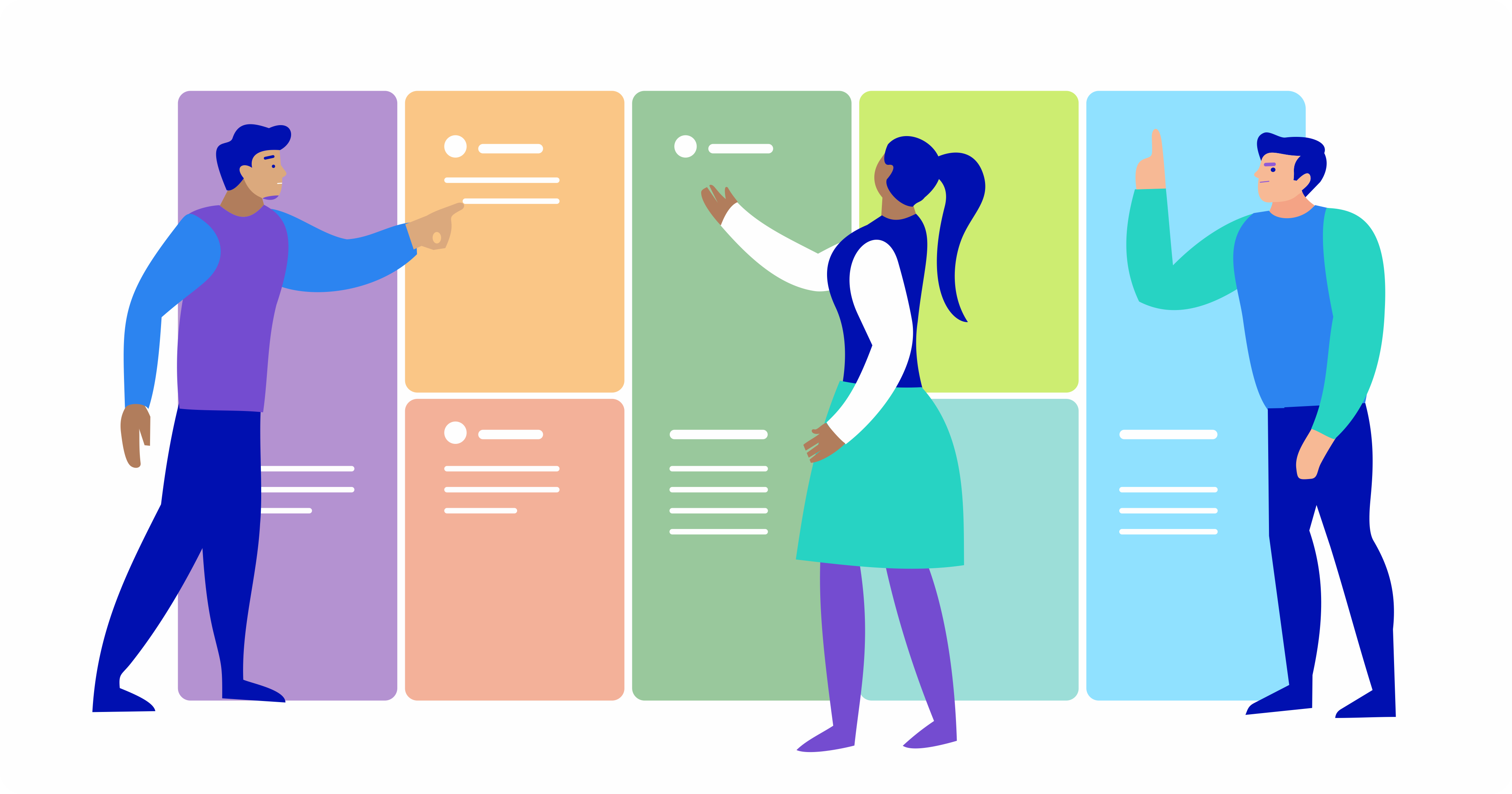
In our recent article on Product Discovery, we talked about what it is, why it’s so important, and how you should go about it. Today, we focus on the nitty-gritty behind it. We cover five brilliant methods for discovering the right products.
We’ve been using them extensively for many years. They’ve saved us from a lot of unpleasant surprises down the road. So today we’d like to cover them in a bit more detail and explain how to approach each of them.
One mistake founders make way too often
First of all, let’s talk about why it all matters so much, especially in the early stages. Because time and time again startup founders, especially inexperienced ones, fall into a very common trap.
They have a brilliant idea for a product that solves a major problem. They immediately fall in love with it and so do their friends and family (except for grumpy uncle Joe who couldn’t care less). They run a quick search for potential competitors and, to no surprise, there are hardly any.
So they frantically start writing down their thoughts and listing key functionalities. They draw a few screens and run to their focus group to get their thoughts on it. The feedback is still overwhelmingly positive.
With growing excitement, they come up with a name, register a domain, and split responsibilities. They also sketch plans for the upcoming months and start relentlessly coding the MVP. Finally, months later, the first, far from perfect prototype, is ready.
A cold shower is what happens next for many of them. Because some ideas simply don’t survive the first encounter with real users. Founding teams are forced to take a few steps back and start revising their initial hypotheses. If it’s small tweaks they need to do at this point, they’re in luck. It is at this very point that many entrepreneurs realize they were building the wrong product from the very beginning.
From our own experience, there’s zero sense in getting into this without proper preparation. So, without further ado, here are some great product discovery methods that we can highly recommend.
Shift your work experience with us – join Railsware
Lean Canvas
Lean Canvas* is a very simple (and yet powerful) tool for evaluating the market you’re about to enter with your product. It helps you look at the problems it’s meant to address and work out what the ideal value proposition of the business should be.
Lean Canvas originated from the similar ideas of Business Model Canvas**. While BMC quickly gained a wide following, it proved to be insufficient for early-stage startups or for getting at the ideas stored in your head. Lean Canvas, designed by Ash Maurya, proved to be more suitable as it shifted the focus to a problem-solution approach.
We’ll get back to BMC towards the end of this article, but for now let’s focus on its younger cousin.
The full Lean Canvas looks like this:
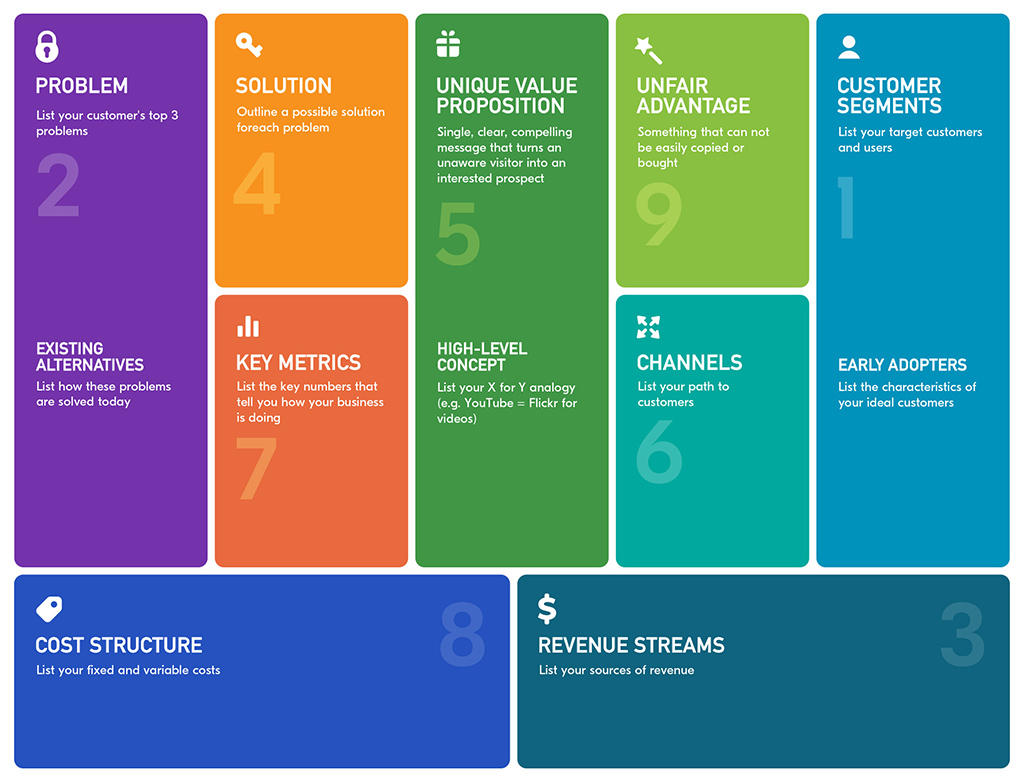
It gives you a holistic view of a business and lets you see how different aspects influence each other. You’re able to have a deeper look at the problems a product can address and the solutions it can bring to its users. Keeping those in mind, you’re able to create a value proposition and find the unfair advantage that may keep the idea ahead of its competitors.
Let’s look at the nine elements that make up the Lean Canvas and analyze them as if we were launching an e-bikes company:
Problems – problems that users of a product have and that your product can address (“Unhealthy lifestyle”, “Time wasted in traffic jams”). Also included here are the Existing Alternatives. List the solutions that currently solve these problems (at least to some extent), e.g. “E-scooters” or even “trains”.
Customer Segments – the specific groups of people that are most likely to use a product. These could be “mid-age corporate workers’ or “students”. To get better focused you’re also encouraged to specify Early Adopters – the ideal users of your product (e.g. “30-40yo professionals living in the suburbs”).
Unique Value Proposition – it’s a brief message where the aim is to attract the attention of those in your Customer Segments. It should explain the solution and its uniqueness. For example, “Cost-effective, an eco-solution for staying fit and getting to work on time”. In this field, include also a High-Level Pitch – a short statement about your product. For example, “Tesla for cyclists”.
Solution – what you include here should directly address the earlier problems, there can be, of course, more than one solution for a problem (and solutions that address multiple problems too!). For example, “effortless riding”, “built-in navigation”, “saves time and physical effort”, “you don’t get sweaty on the way to the office:)”, “cheaper alternative to a car”
Unfair Advantage – here, list the factors contributing to the uniqueness of a business, making it difficult for competitors to copy it. This could be “patents”, “exclusive deals with Trek and Specialized”, and so on.
Revenue Streams – this is, of course, about how you’re going to make money, i.e. “Corporate sales”, “Subscription for premium features”
Cost Structure – here you’ll include what the runway will be spent on – “office rental”, “manufacturing”, “salaries”, etc.
Key Metrics – list how progress will be measured, be as specific as possible (“# of preorders“, “hours driven”)
Channels – and finally, here you need to include the channels that the business will use to communicate with its customers – “email newsletters”, “social media”, “printed ads” etc.
Note that we placed the elements in the order that’s often recommended for first-time Lean Canvas-ers. But, the author of the framework himself argues that there’s no perfect order to tackle the sheet in.
Lean Canvas is particularly great because, as you would expect from its name, it allows you to stay lean. It’s quick to build and doesn’t distract you from other tasks for long. Also, it’s very easy to adapt.
If you’re not familiar with the lean methodology, press pause on this article and check out our guide about lean product management.
So, by all means, don’t just fill in the sheet and leave it in a folder for a future reference. Lean Canvas is meant to be scribbled on, revised, recreated from scratch. Just like many of your initial assumptions will change, so should the contents of your canvas.
It’s good practice to revise it on a regular basis with the founding team and to adapt it to changing circumstances. As the years go by, the business is likely to find its path. Even then, looking at the good ol’ Lean Canvas may bring up some fresh ideas or challenge some hypotheses.
At the same time, it’s worth noting that Lean Canvas only briefly focuses on the folks that will make a major difference in whether a startup succeeds or not – the customers. For this reason, it’s worth combining it with another framework known as Value Proposition Canvas***. We’ll talk about this in the following chapter.
Ready to get started with Lean Canvas? We’ve covered it in a lot more detail, along with instructions for completing it step-by-step. Check out our Lean Canvas article as well as real-life examples of Lean Canvas. See also the video below where we discuss one of the examples.
Value Proposition Canvas
VPC is another framework that’s really popular among startup founders. As we just mentioned, it’s focused more on the users of a product, their problems, and solutions that would relieve them from their pains. It’s a tool for finding the right balance between what customers need and what you should deliver, and are capable of delivering.
Since balancing two factors is involved, there are also two sides to the Value Proposition Canvas:
Most product people start from the circle to the right. There, you work on three factors related to the users:
Customer job(s) – these are the tasks that customers, consciously or not, want to be tackled. They can come from different spheres – functional (‘I want to have the grass cut with minimum effort on my part’), social (‘I want neighbors to admire my wonderful garden’) as well as emotional (‘I want to feel good about myself’).
Pains – here you list the negative experiences, emotions, and issues that a customer may experience while getting the jobs done (with the methods currently at hand). (‘I waste a lot of time cutting the grass’, ‘My grass mower is loud and neighbors hate me’, ‘Fuel is expensive’ etc.)
Gains – and finally, you list the ambitions users have, their goals and desires in life. These can be totally unrelated to the pains you listed (‘I want to spend more time with my family’ or ‘I want a clean garden with 0 effort on my side’)
If you’re getting started with a product, you’ll need to try putting yourself in the customer’s shoes to fill this part of the sheet. This inevitably leads to some guessing and making assumptions about what users want or what troubles them. After some serious brainstorming, you’ll likely have some major hypotheses about their pains and gains. Here’s a pro tip – try to base your answers on a lot more than just hypotheses.
If you can, do as little guessing as possible. Instead, support what you write with data and genuine inputs from users. Here are some battle-tested customer development methods that have proved priceless for various products we’ve developed over the years:
Interviews the users. Grab some early adopters and/or most active users for calls. Ask them about their problems, about what they appreciate in your solution and what else could help them. You’ll get a lot of input from many different perspectives, some of which you may have not thought about.
Share a feedback form as a pop-up on your site using pop-up software, a post on social media or a link in a newsletter. Give as many users as possible an easy way of voluntarily sharing some thoughts about your product. Pick the most constructive ones and reach out to them to learn more.
Run exit interviews with users that abandoned your platform – cancelled a subscription or simply became inactive. Send them personalized emails and ask them to join you for a quick call. They’ll tell you precisely why they left and the chances are you’ll find a way to make good use of it.
The more inputs you get, the more accurate your VPC will be, and that’s what you should always be aiming for.
Going back to the Value Proposition Canvas, after you’ve completed the right-hand part of it, it’s time for tackling the left side. What’s there directly corresponds to your earlier inputs. It’s time to look at the value that your product can deliver:
Products and Services – here you should list which elements of your offering will address the needs and wants your customers have. These can be products (‘SuperMower 2030’) or parts of your offering (‘lifetime warranty’, ‘online dashboard’, ‘premium support’)
Pain Relievers are the aspects of your solution that, well, relieve users from the pains that trouble them. These could be “autonomous mowing’, ‘silent mode’, and so on.
Gain Creators is about the value your product will deliver. The value that directly corresponds to the gains your customers hope to have fulfilled. For example, ‘quick setup’, ‘smart charging’, ‘24/7 support line”. Some ‘Pain Relievers’ could be repeated here but that’s absolutely fine.
Finally, once you have the canvas completed, you should see if there’s a balance between both sides. In other words, you need to check that there’s a fit between what customers want and what your product is able to deliver.
You go through each of the items on the right side and check if there’s an equivalent on the left side. The more ‘matches’ you score, the better the chance of attracting these particular customers to use your product or service. If a lot of pains or gains are left unanswered, you should probably consider a pivot of some sort. If there’s a clear match, you’re clearly headed in the right direction.
Check out our Value Proposition Canvas article for more examples and a more in-depth look at this framework.
VPC complements Lean Canvas in a very efficient way. The first framework we talked about earlier focuses mostly on the business side, what it can offer and where main risks lie. Value Proposition Canvas offers an excellent insight into the minds of customers. It’s great at assessing if you’re aiming for the right product-market fit. It can also suggest a completely different perspective that you should look at the problem from.
We highly recommend using both Lean Canvas and VPC together. But, there’s also the third method that’s our preferred choice whenever we’re working on product discovery. It has a lot in common with Value Proposition Canvas but offers a more in-depth insight into things that will be important to you, especially at the very early stage.
We have lots of knowledge to share with you. Join Railsware team
Inception
The third method on the list is the one we frequently used before creating our own product discovery framework BRIDGeS (more details on that below).
Inception is a battle-tested method for product discovery that takes us from a bare idea to a roadmap that’s ready to be executed by the team already on board.
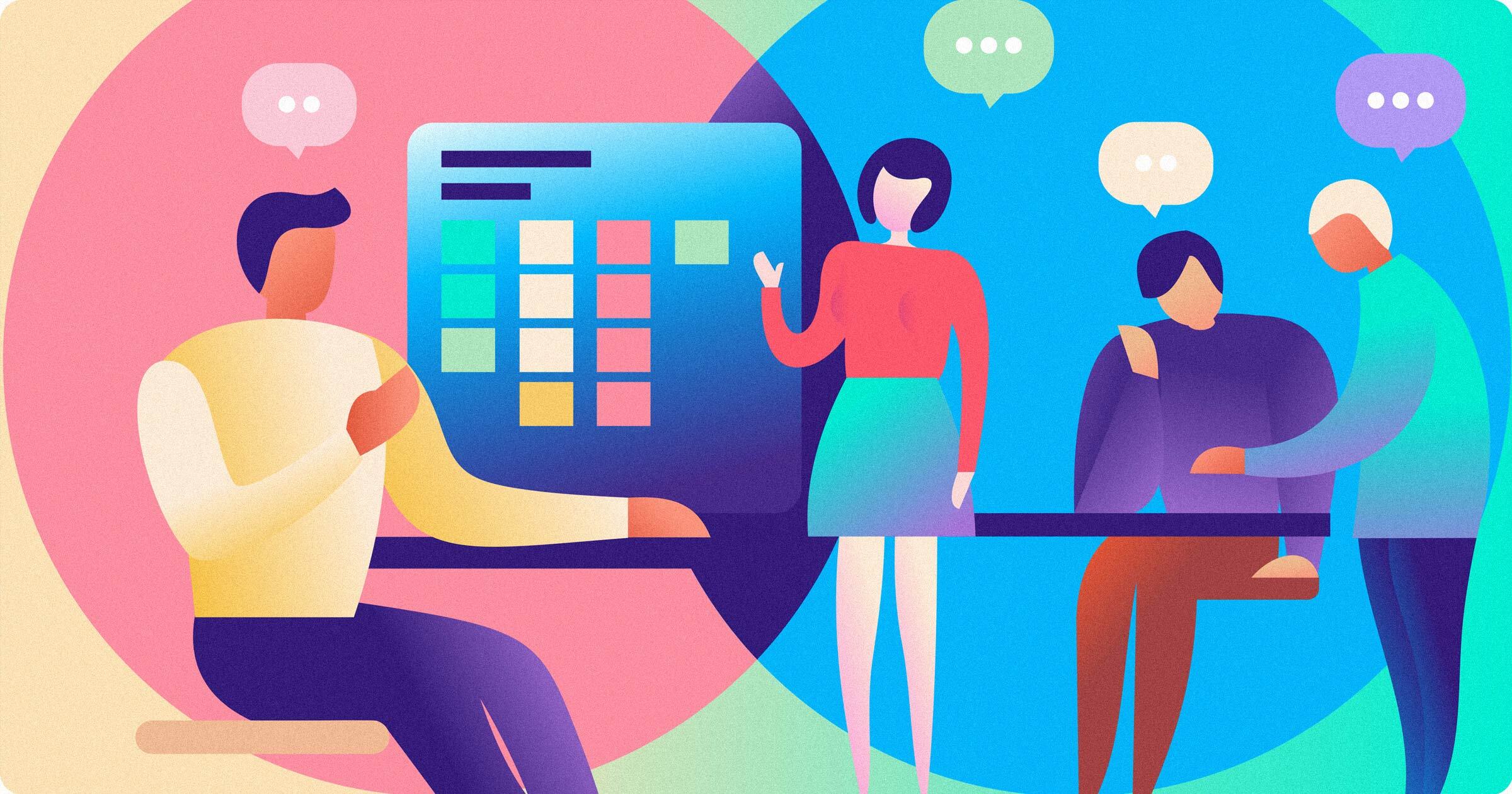
We learned about Inception from our friends at Pivotal Labs, who have been using it with a lot of success for many years. We implemented it for the first time in 2011 and have been improving it ever since. We’ve also adapted various aspects from the two methods we just talked about.
Because of that, you might spot many similarities between VPC and Inception:
- They use the same user-centric approach
- Inception relies on a similar pains & gains mechanism, with a focus on mapping solutions to diagnosed problems
- It also features a similar concept to VPC’s Jobs, here referred to as “Domain Knowledge”
Contrary to the other two methods, an Inception for a product is hardly a quick matter. It usually requires the product team to spend 2-3 days together, discussing different concepts and coming up with ready-to-use solutions. But, this is not time wasted by any means. Planning done this way can prevent serious failures down the road and effectively save everyone plenty of time in the future.
In short, here’s how Inception goes, step by step. If you’re interested in reading in more detail about each step, we recommend that you check our other article on Agile Inception.
- Preparations phase – the founding team gathers the relevant data about their product. These could be mockups, prototypes, customer feedback, competitor analysis. The Railsware product team does its part too, to gain a better understanding of the market and competing solutions.
- Check-in and demo – Teams meet up, get to know each other and the founding team presents everything they’ve worked so diligently on so far.
- Customer roles – In this part, we focus on the different customer types that will interact with a product (e.g. “individuals”, “companies”, “public institutions”). For each customer type, we list issues corresponding to them, benefits that we can create, and risks we associate with them. We also reference any domain knowledge we’ve managed to accumulate about discussed roles.
- Solution Ideas. Directions. Variations. – Based on our earlier findings, we discuss the high-level direction that we should take. This could be building a web dashboard or mobile app. We don’t need to go into specific details just yet.
- Application Roles – Next, we think about various roles that will impact the product in some way. This is a wider term than the “Customer Roles” we talked about earlier as it can include any stakeholders, even those within the company. For example, “Drivers”, “Coordinators”, “Community Managers” etc. We discuss the details of each role and decide which should be our focus.
- Epics and Features Breakdown – This is when we get into the details. We brainstorm epics that we deem the most important and analyze if they will address the issues we’ve previously diagnosed. If they don’t, they should probably make way for other epics. We then rank the epics using the MoSCoW method so we can filter out the optional features and focus most of our efforts on the must-haves.
- Action Plan – Having a list of most important epics to work with, we break them down into smaller tasks. We then split the responsibilities and build a product roadmap. This part deserves a longer explanation.
A product roadmap is the end-goal of an Inception. We believe it’s a crucial goal. Teams don’t just leave the meeting with a better understanding of the clients and ideas in their heads. They have a specific action plan to work with and can get started on it the following morning. What’s more, it’s a fantastic reference for any product manager that can be actively used and revised throughout the product cycle.
A roadmap can take many different forms and we will choose the right one depending on the product at hand, its stage, and complexity. But in general, the process comes down to:
- Picking the right tool (and there’s plenty to choose from, both online and offline)
- Laying out the outline for a roadmap – choosing between deadline or non-deadline-based roadmap, picking the right metrics and a format
- Prioritizing the items (as we did in the Epics and Features Breakdown step) and distributing them onto a roadmap
There’s a lot more to the topic. By all means, check out our tutorial on product roadmaps.
Going back to Inception for a brief moment, there are many reasons why we love this approach:
- It’s really successful at preventing major product pitfalls. It looks at every important aspect of product delivery and lets the product team pick the right direction from the get-go.
- The team is ready to start right away. There’s no need for briefing, knowledge sharing, discussions and planning a roadmap. It’s already done by the time we leave the room. Everyone’s on the same page.
- It’s a great way to integrate the team, work out the right approach, and create a joint vision for everyone to follow.
Our team had been practicing Inception for quite a while both on our and our clients’ products. And when we faced some minor limitations of the toolб we made some changes in its flow. We adjusted the framework more and more, tweaking activities and components until we made something brand new – BRIDGeS.
BRIDGeS
BRIDGeS is a framework created by our team and tested on dozens of products. This framework has taken a lot from the tools we described above. Then it was modified, improved, simplified, and adapted to our needs. As a result, we’ve got a paradigm-shifting instrument that is aligned with the agile methodology enough to be used not only for product discovery, but also for decision-making, strategy and operation building, and much more.
The framework consists of four steps that lead to a new solution and a product roadmap.
- Problem description. This step requires you to identify the Subject(s) that will benefit from the problem solution. Then, you investigate the context, defining the following Subject’s descriptors: Benefits, Risks, Issues, Domain knowledge, and Goals. All the collected data should be visually represented in a Problem Space.
- Prioritization. Prioritize each descriptor to see which aspects are crucial and which will have the least impact on your future solution. Our team prefers using the MoSCoW technique, however, you can choose any prioritization approach you like more.
- Solution variation. When the problem context is collected and analyzed, you move to the Solution space. List the solutions that can potentially cover essential requirements mentioned during the Problem description stage. To compare solution variation and choose the most optimal one, you can analyze each using the same set of descriptors as when you investigated the problem.
- Solution Breakdown. A chosen solution variation is then destructured into epics and nested tasks so that each covers critical requirements from the Problem space. You can also do space mapping to ensure you didn’t miss anything. Then, prioritize tasks, and transform them into a product roadmap.
One of the biggest differences that the framework makes is that we can use it on a daily basis for almost all sorts of tasks, be it a company’s strategy, new product feature design, or a search for the team office. Here’s what makes BRIDGeS so powerful and universal:
- An extensive set of descriptors helps investigate content more thoroughly from different perspectives. The first thing we usually define is the Subject’s Goals that can drastically shift our focus from what we thought was a problem.
- Prioritization of descriptors allows us to define the most critical things that will influence a future solution or decision.
- Analysis of Solution variations helps us find hidden risks and opportunities of each option and make a well-weighted choice.
- Straightforward flow allows us to shorten and streamline BRIDGeS sessions. A minimized number of steps and activities result in maximum value and make the framework applicable to any project or situation.
Visit our website to find out what advantages you can get with BRIDGeS. And if you want to know how the BRIDGeS discovery session is run step by step, please check out the Uber example.

Bonus: Business Model Canvas
As mentioned earlier, let’s get back to BMC for a moment, even though it’s not exactly a product discovery technique. It’s more of a tool that can help existing businesses find the right path.
Once you have gone through the initial Product Discovery cycle described above, start using BMC. That way, you can constantly keep track of your business model and adapt it when necessary. It works perfectly well with the Value Proposition Canvas, as well as the Inception approach. It’s best used when you need to re-evaluate the market and come up with a road map for the upcoming period.
*Business Model Canvas was designed by Alex Osterwalder, Strategyzer.com, licensed under CC BY SA 3.0.
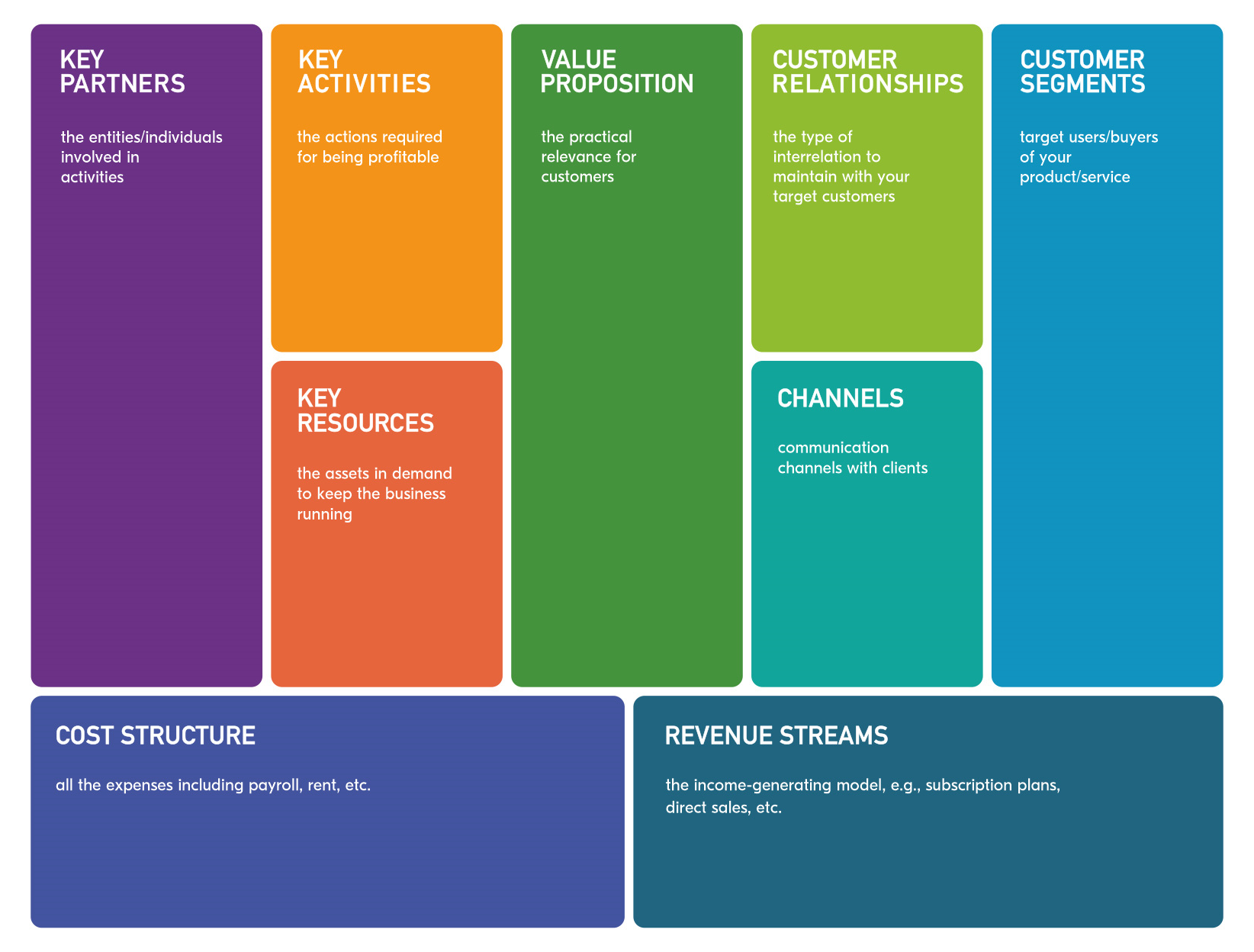
BMC’s creator, Alexander Osterwalder, argued that writing a detailed business plan is usually a big waste of time, and it’s hard to disagree with him. Unless the founders are applying for a bank loan or another form of funding, writing a 100-page document with predictions and analysis is unlikely to give their business a major head start.
To address this, BMC takes a more action-oriented approach. It marginalizes the irrelevant data and lets you focus on the nine most important factors for the business, each fitting on a single page. This forces you to be concise and work with only the most relevant factors, leaving all the clutter for more formal papers.
The end result is a snapshot of a company easy to analyze, and where it is easy to spot risks and find opportunities. When this comes into fruition, you’re much more well equipped to come up with a valid value proposition that a business can deliver.
As always, kindly refer to our dedicated article on Business Model Canvas for more detail.
Wrapping up
These are the five product discovery methods that we highly recommend. Some can be implemented during an extended lunch break. Others need a bit more effort but will offer a lot more insight that will be crucial for any start-up founder at some point.
Be sure to follow our blog, where we discuss different product methodologies that we actively use for our products. If you’re a product manager or are aspiring to become one, you’ll find here lots of knowledge, tools, and practical tips. You’ll also come across insights from Railsware life and various elements of our culture that we proudly like to share with the world.
If you’re looking for new opportunities, check out our career pages. Chances are, we may be looking for someone just like you.
* Lean Canvas was designed by Ash Maurya, based on the Business Model Canvas designed by Alex Osterwalder, Strategyzer.com, licensed under CC BY SA 3.0.
** Business Model Canvas is designed by Alex Osterwalder, Strategyzer.com, licensed under CC BY SA 3.0.
*** Value Proposition Canvas is designed by Alex Osterwalder, Strategyzer.com.

